AI, Automation, and the Future of Work: A Presentation Analysis
VerifiedAdded on 2021/04/05
|6
|2106
|98
Presentation
AI Summary
This presentation discusses the significant impact of artificial intelligence (AI), automation, and the COVID-19 pandemic on the future job market. It presents compelling evidence from various studies, including those from Oxford University and Pew Research, to support the claim that a substantial percentage of jobs are at risk of disappearing within the next decade. The presentation highlights automation as a primary driver of job displacement, citing the rise of self-driving cars, autonomous ships, and autopilot aircraft as examples of technological advancements. Furthermore, it explores how AI is poised to replace roles in various sectors, from manufacturing and human resources to finance and translation. The outbreak of COVID-19 is also discussed as an accelerant of automation and AI adoption, leading to further job reductions across diverse industries. The presentation concludes by emphasizing the need for individuals to adapt and acquire new skills to remain competitive in the evolving job market, while also highlighting the potential for AI and automation to create new opportunities and drive innovation. The presentation suggests that while job losses are inevitable, continuous learning and skill development are crucial for navigating the future of work.
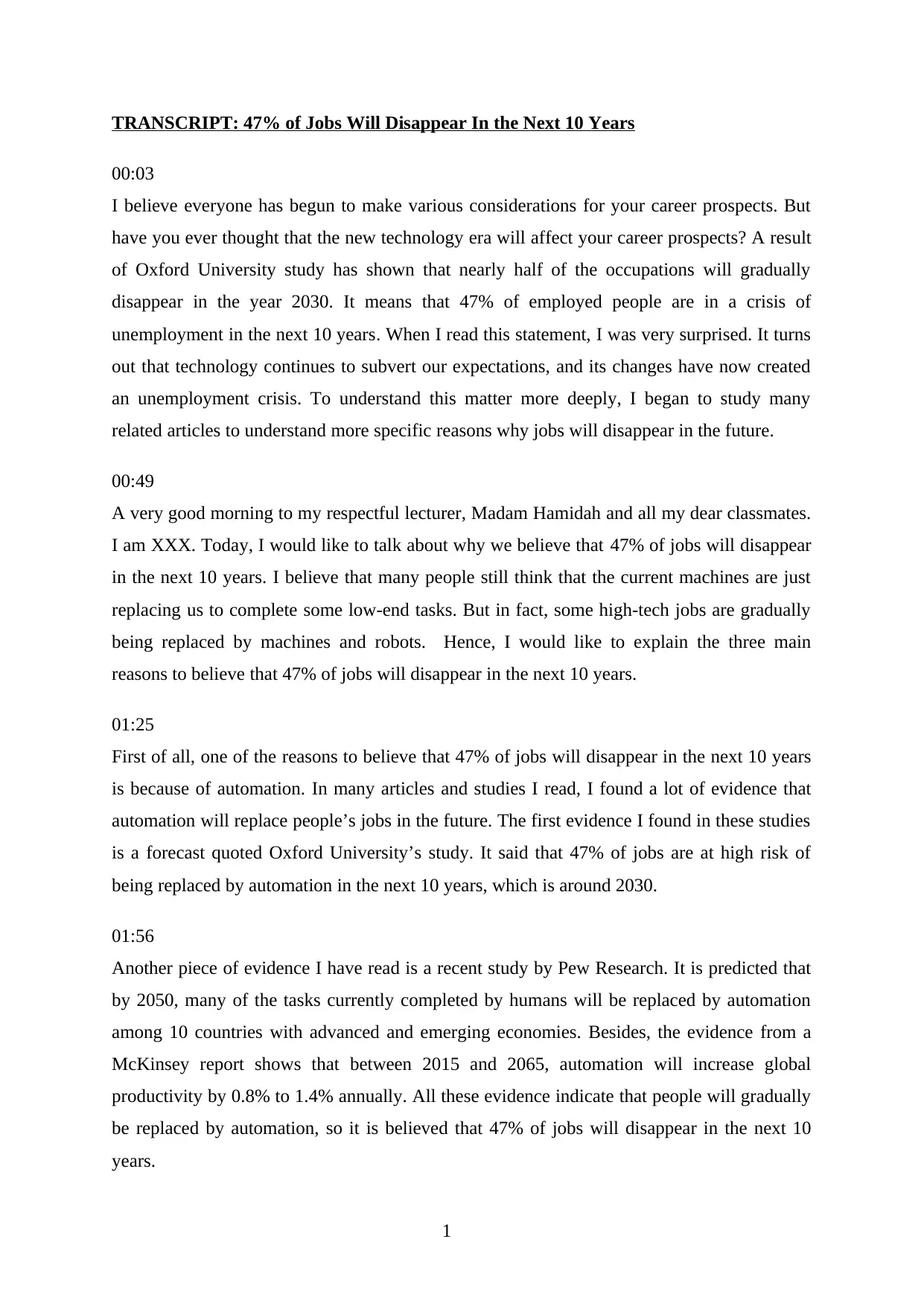
TRANSCRIPT: 47% of Jobs Will Disappear In the Next 10 Years
00:03
I believe everyone has begun to make various considerations for your career prospects. But
have you ever thought that the new technology era will affect your career prospects? A result
of Oxford University study has shown that nearly half of the occupations will gradually
disappear in the year 2030. It means that 47% of employed people are in a crisis of
unemployment in the next 10 years. When I read this statement, I was very surprised. It turns
out that technology continues to subvert our expectations, and its changes have now created
an unemployment crisis. To understand this matter more deeply, I began to study many
related articles to understand more specific reasons why jobs will disappear in the future.
00:49
A very good morning to my respectful lecturer, Madam Hamidah and all my dear classmates.
I am XXX. Today, I would like to talk about why we believe that 47% of jobs will disappear
in the next 10 years. I believe that many people still think that the current machines are just
replacing us to complete some low-end tasks. But in fact, some high-tech jobs are gradually
being replaced by machines and robots. Hence, I would like to explain the three main
reasons to believe that 47% of jobs will disappear in the next 10 years.
01:25
First of all, one of the reasons to believe that 47% of jobs will disappear in the next 10 years
is because of automation. In many articles and studies I read, I found a lot of evidence that
automation will replace people’s jobs in the future. The first evidence I found in these studies
is a forecast quoted Oxford University’s study. It said that 47% of jobs are at high risk of
being replaced by automation in the next 10 years, which is around 2030.
01:56
Another piece of evidence I have read is a recent study by Pew Research. It is predicted that
by 2050, many of the tasks currently completed by humans will be replaced by automation
among 10 countries with advanced and emerging economies. Besides, the evidence from a
McKinsey report shows that between 2015 and 2065, automation will increase global
productivity by 0.8% to 1.4% annually. All these evidence indicate that people will gradually
be replaced by automation, so it is believed that 47% of jobs will disappear in the next 10
years.
1
00:03
I believe everyone has begun to make various considerations for your career prospects. But
have you ever thought that the new technology era will affect your career prospects? A result
of Oxford University study has shown that nearly half of the occupations will gradually
disappear in the year 2030. It means that 47% of employed people are in a crisis of
unemployment in the next 10 years. When I read this statement, I was very surprised. It turns
out that technology continues to subvert our expectations, and its changes have now created
an unemployment crisis. To understand this matter more deeply, I began to study many
related articles to understand more specific reasons why jobs will disappear in the future.
00:49
A very good morning to my respectful lecturer, Madam Hamidah and all my dear classmates.
I am XXX. Today, I would like to talk about why we believe that 47% of jobs will disappear
in the next 10 years. I believe that many people still think that the current machines are just
replacing us to complete some low-end tasks. But in fact, some high-tech jobs are gradually
being replaced by machines and robots. Hence, I would like to explain the three main
reasons to believe that 47% of jobs will disappear in the next 10 years.
01:25
First of all, one of the reasons to believe that 47% of jobs will disappear in the next 10 years
is because of automation. In many articles and studies I read, I found a lot of evidence that
automation will replace people’s jobs in the future. The first evidence I found in these studies
is a forecast quoted Oxford University’s study. It said that 47% of jobs are at high risk of
being replaced by automation in the next 10 years, which is around 2030.
01:56
Another piece of evidence I have read is a recent study by Pew Research. It is predicted that
by 2050, many of the tasks currently completed by humans will be replaced by automation
among 10 countries with advanced and emerging economies. Besides, the evidence from a
McKinsey report shows that between 2015 and 2065, automation will increase global
productivity by 0.8% to 1.4% annually. All these evidence indicate that people will gradually
be replaced by automation, so it is believed that 47% of jobs will disappear in the next 10
years.
1
Paraphrase This Document
Need a fresh take? Get an instant paraphrase of this document with our AI Paraphraser
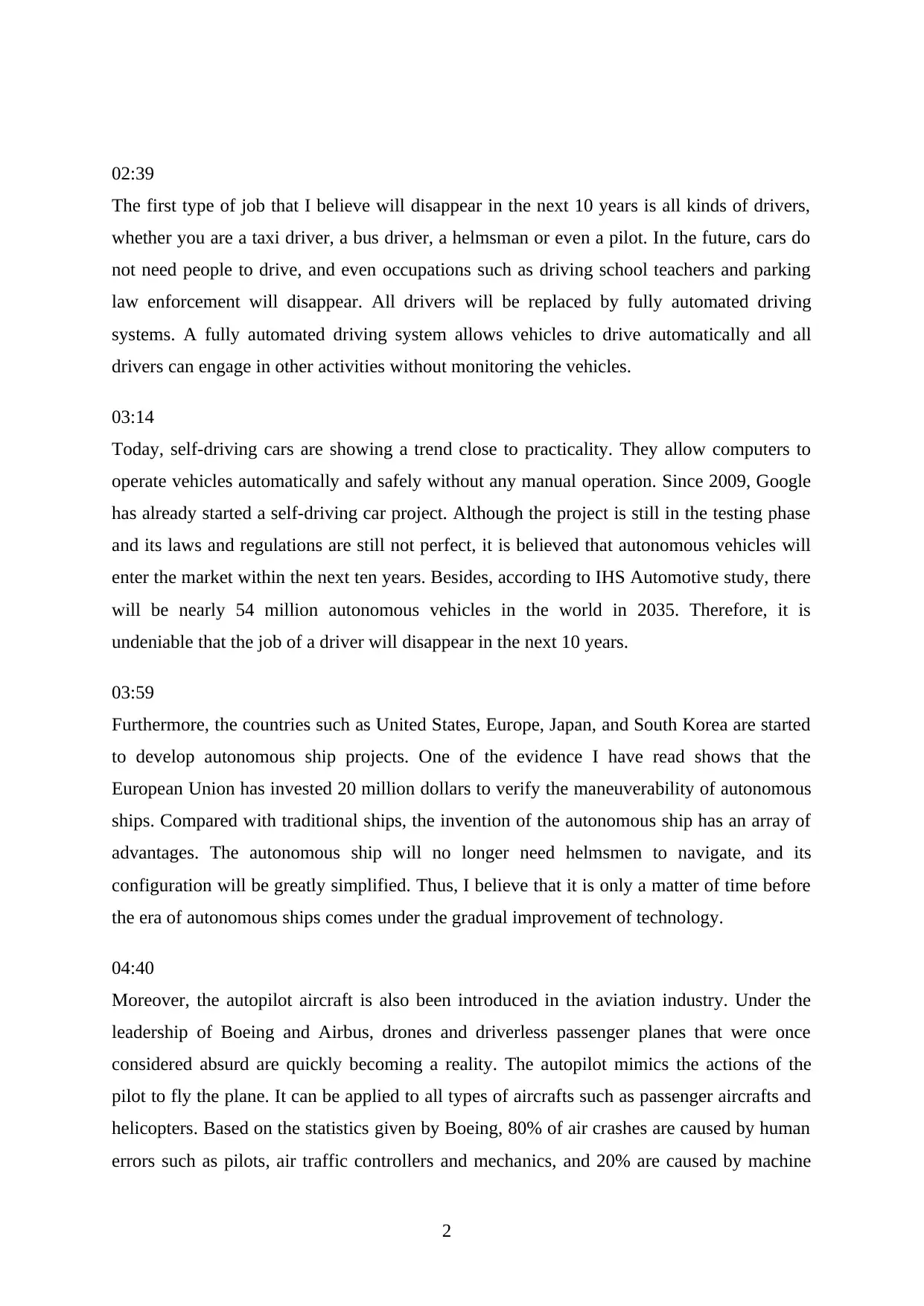
02:39
The first type of job that I believe will disappear in the next 10 years is all kinds of drivers,
whether you are a taxi driver, a bus driver, a helmsman or even a pilot. In the future, cars do
not need people to drive, and even occupations such as driving school teachers and parking
law enforcement will disappear. All drivers will be replaced by fully automated driving
systems. A fully automated driving system allows vehicles to drive automatically and all
drivers can engage in other activities without monitoring the vehicles.
03:14
Today, self-driving cars are showing a trend close to practicality. They allow computers to
operate vehicles automatically and safely without any manual operation. Since 2009, Google
has already started a self-driving car project. Although the project is still in the testing phase
and its laws and regulations are still not perfect, it is believed that autonomous vehicles will
enter the market within the next ten years. Besides, according to IHS Automotive study, there
will be nearly 54 million autonomous vehicles in the world in 2035. Therefore, it is
undeniable that the job of a driver will disappear in the next 10 years.
03:59
Furthermore, the countries such as United States, Europe, Japan, and South Korea are started
to develop autonomous ship projects. One of the evidence I have read shows that the
European Union has invested 20 million dollars to verify the maneuverability of autonomous
ships. Compared with traditional ships, the invention of the autonomous ship has an array of
advantages. The autonomous ship will no longer need helmsmen to navigate, and its
configuration will be greatly simplified. Thus, I believe that it is only a matter of time before
the era of autonomous ships comes under the gradual improvement of technology.
04:40
Moreover, the autopilot aircraft is also been introduced in the aviation industry. Under the
leadership of Boeing and Airbus, drones and driverless passenger planes that were once
considered absurd are quickly becoming a reality. The autopilot mimics the actions of the
pilot to fly the plane. It can be applied to all types of aircrafts such as passenger aircrafts and
helicopters. Based on the statistics given by Boeing, 80% of air crashes are caused by human
errors such as pilots, air traffic controllers and mechanics, and 20% are caused by machine
2
The first type of job that I believe will disappear in the next 10 years is all kinds of drivers,
whether you are a taxi driver, a bus driver, a helmsman or even a pilot. In the future, cars do
not need people to drive, and even occupations such as driving school teachers and parking
law enforcement will disappear. All drivers will be replaced by fully automated driving
systems. A fully automated driving system allows vehicles to drive automatically and all
drivers can engage in other activities without monitoring the vehicles.
03:14
Today, self-driving cars are showing a trend close to practicality. They allow computers to
operate vehicles automatically and safely without any manual operation. Since 2009, Google
has already started a self-driving car project. Although the project is still in the testing phase
and its laws and regulations are still not perfect, it is believed that autonomous vehicles will
enter the market within the next ten years. Besides, according to IHS Automotive study, there
will be nearly 54 million autonomous vehicles in the world in 2035. Therefore, it is
undeniable that the job of a driver will disappear in the next 10 years.
03:59
Furthermore, the countries such as United States, Europe, Japan, and South Korea are started
to develop autonomous ship projects. One of the evidence I have read shows that the
European Union has invested 20 million dollars to verify the maneuverability of autonomous
ships. Compared with traditional ships, the invention of the autonomous ship has an array of
advantages. The autonomous ship will no longer need helmsmen to navigate, and its
configuration will be greatly simplified. Thus, I believe that it is only a matter of time before
the era of autonomous ships comes under the gradual improvement of technology.
04:40
Moreover, the autopilot aircraft is also been introduced in the aviation industry. Under the
leadership of Boeing and Airbus, drones and driverless passenger planes that were once
considered absurd are quickly becoming a reality. The autopilot mimics the actions of the
pilot to fly the plane. It can be applied to all types of aircrafts such as passenger aircrafts and
helicopters. Based on the statistics given by Boeing, 80% of air crashes are caused by human
errors such as pilots, air traffic controllers and mechanics, and 20% are caused by machine
2
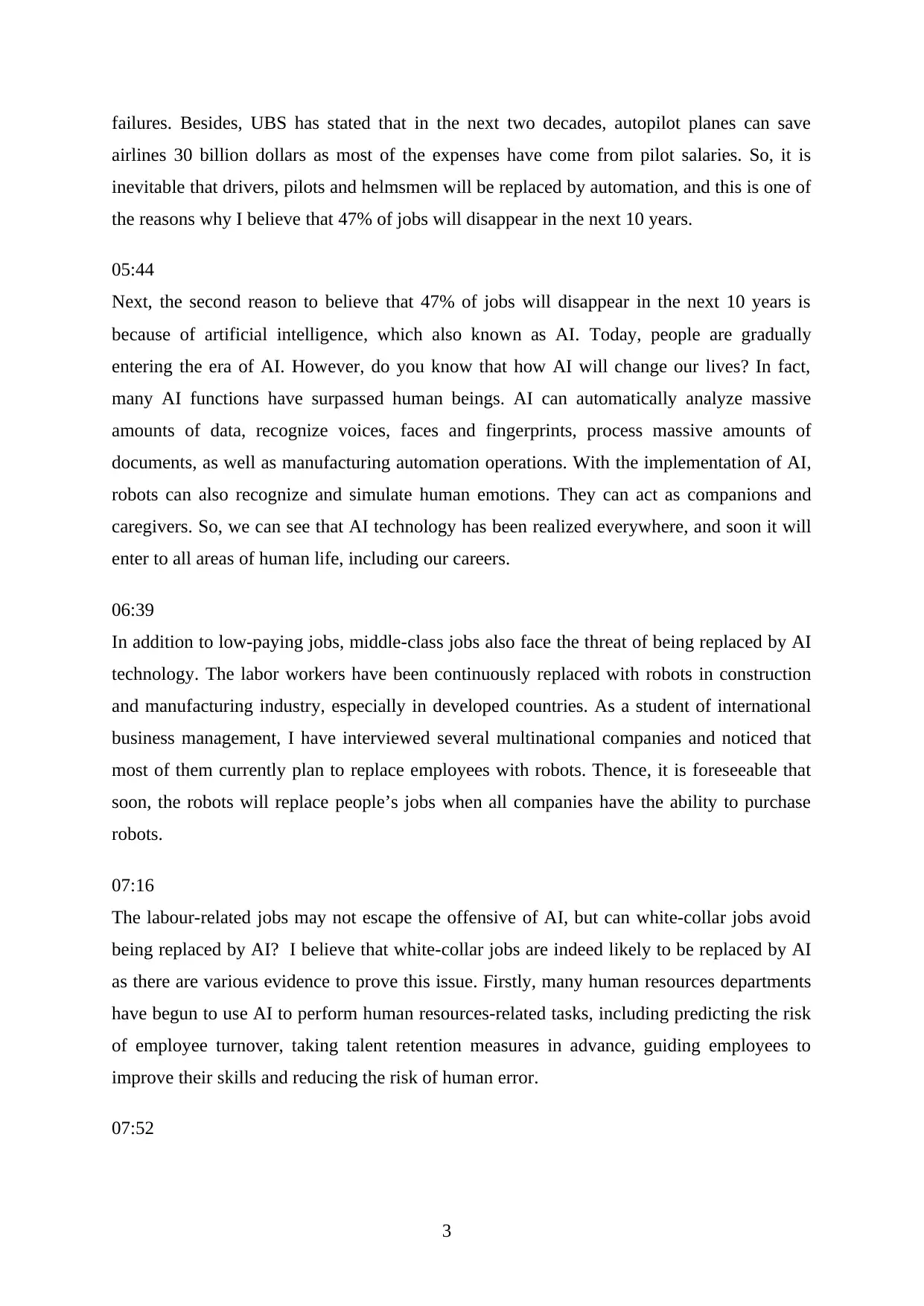
failures. Besides, UBS has stated that in the next two decades, autopilot planes can save
airlines 30 billion dollars as most of the expenses have come from pilot salaries. So, it is
inevitable that drivers, pilots and helmsmen will be replaced by automation, and this is one of
the reasons why I believe that 47% of jobs will disappear in the next 10 years.
05:44
Next, the second reason to believe that 47% of jobs will disappear in the next 10 years is
because of artificial intelligence, which also known as AI. Today, people are gradually
entering the era of AI. However, do you know that how AI will change our lives? In fact,
many AI functions have surpassed human beings. AI can automatically analyze massive
amounts of data, recognize voices, faces and fingerprints, process massive amounts of
documents, as well as manufacturing automation operations. With the implementation of AI,
robots can also recognize and simulate human emotions. They can act as companions and
caregivers. So, we can see that AI technology has been realized everywhere, and soon it will
enter to all areas of human life, including our careers.
06:39
In addition to low-paying jobs, middle-class jobs also face the threat of being replaced by AI
technology. The labor workers have been continuously replaced with robots in construction
and manufacturing industry, especially in developed countries. As a student of international
business management, I have interviewed several multinational companies and noticed that
most of them currently plan to replace employees with robots. Thence, it is foreseeable that
soon, the robots will replace people’s jobs when all companies have the ability to purchase
robots.
07:16
The labour-related jobs may not escape the offensive of AI, but can white-collar jobs avoid
being replaced by AI? I believe that white-collar jobs are indeed likely to be replaced by AI
as there are various evidence to prove this issue. Firstly, many human resources departments
have begun to use AI to perform human resources-related tasks, including predicting the risk
of employee turnover, taking talent retention measures in advance, guiding employees to
improve their skills and reducing the risk of human error.
07:52
3
airlines 30 billion dollars as most of the expenses have come from pilot salaries. So, it is
inevitable that drivers, pilots and helmsmen will be replaced by automation, and this is one of
the reasons why I believe that 47% of jobs will disappear in the next 10 years.
05:44
Next, the second reason to believe that 47% of jobs will disappear in the next 10 years is
because of artificial intelligence, which also known as AI. Today, people are gradually
entering the era of AI. However, do you know that how AI will change our lives? In fact,
many AI functions have surpassed human beings. AI can automatically analyze massive
amounts of data, recognize voices, faces and fingerprints, process massive amounts of
documents, as well as manufacturing automation operations. With the implementation of AI,
robots can also recognize and simulate human emotions. They can act as companions and
caregivers. So, we can see that AI technology has been realized everywhere, and soon it will
enter to all areas of human life, including our careers.
06:39
In addition to low-paying jobs, middle-class jobs also face the threat of being replaced by AI
technology. The labor workers have been continuously replaced with robots in construction
and manufacturing industry, especially in developed countries. As a student of international
business management, I have interviewed several multinational companies and noticed that
most of them currently plan to replace employees with robots. Thence, it is foreseeable that
soon, the robots will replace people’s jobs when all companies have the ability to purchase
robots.
07:16
The labour-related jobs may not escape the offensive of AI, but can white-collar jobs avoid
being replaced by AI? I believe that white-collar jobs are indeed likely to be replaced by AI
as there are various evidence to prove this issue. Firstly, many human resources departments
have begun to use AI to perform human resources-related tasks, including predicting the risk
of employee turnover, taking talent retention measures in advance, guiding employees to
improve their skills and reducing the risk of human error.
07:52
3
⊘ This is a preview!⊘
Do you want full access?
Subscribe today to unlock all pages.

Trusted by 1+ million students worldwide
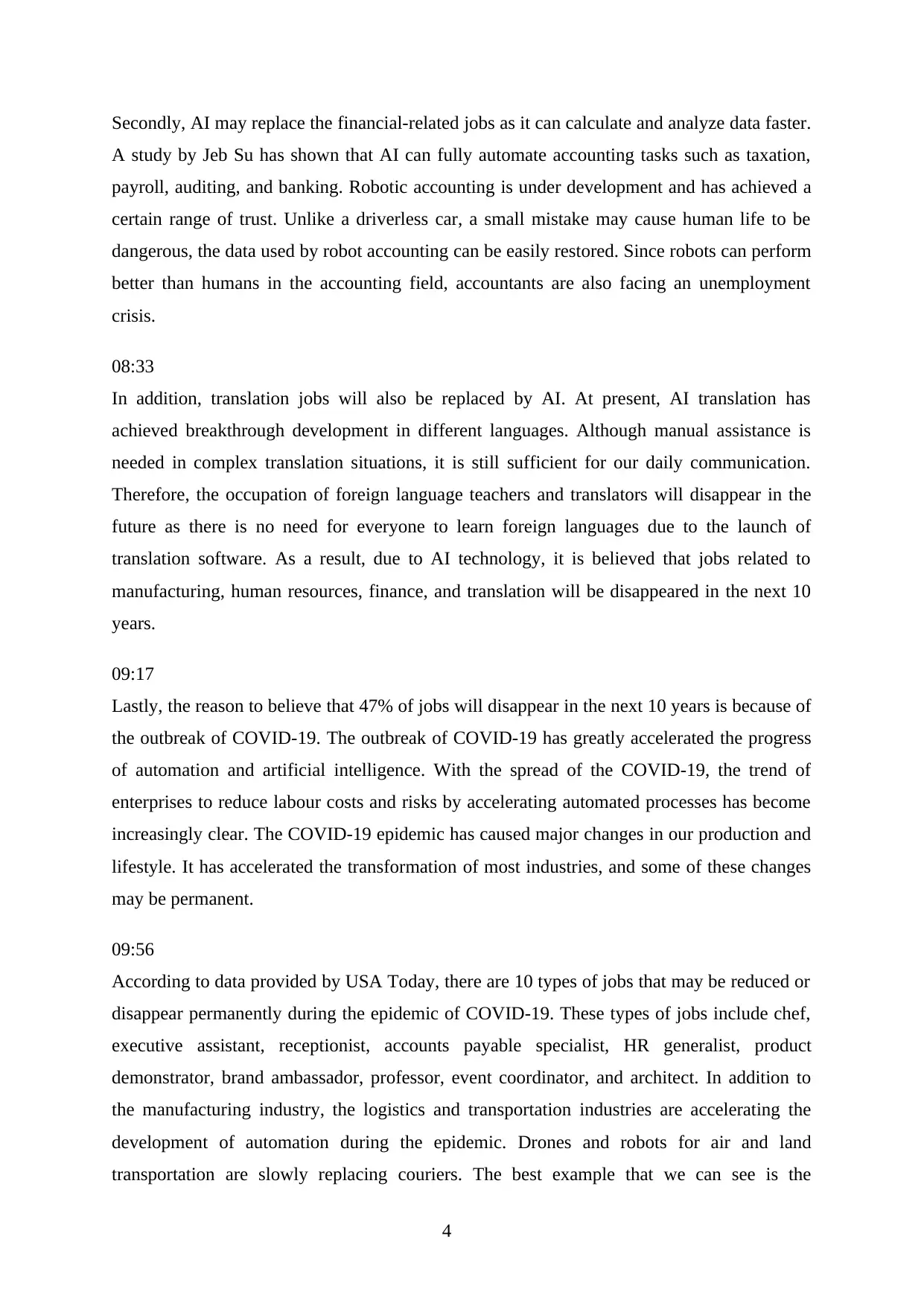
Secondly, AI may replace the financial-related jobs as it can calculate and analyze data faster.
A study by Jeb Su has shown that AI can fully automate accounting tasks such as taxation,
payroll, auditing, and banking. Robotic accounting is under development and has achieved a
certain range of trust. Unlike a driverless car, a small mistake may cause human life to be
dangerous, the data used by robot accounting can be easily restored. Since robots can perform
better than humans in the accounting field, accountants are also facing an unemployment
crisis.
08:33
In addition, translation jobs will also be replaced by AI. At present, AI translation has
achieved breakthrough development in different languages. Although manual assistance is
needed in complex translation situations, it is still sufficient for our daily communication.
Therefore, the occupation of foreign language teachers and translators will disappear in the
future as there is no need for everyone to learn foreign languages due to the launch of
translation software. As a result, due to AI technology, it is believed that jobs related to
manufacturing, human resources, finance, and translation will be disappeared in the next 10
years.
09:17
Lastly, the reason to believe that 47% of jobs will disappear in the next 10 years is because of
the outbreak of COVID-19. The outbreak of COVID-19 has greatly accelerated the progress
of automation and artificial intelligence. With the spread of the COVID-19, the trend of
enterprises to reduce labour costs and risks by accelerating automated processes has become
increasingly clear. The COVID-19 epidemic has caused major changes in our production and
lifestyle. It has accelerated the transformation of most industries, and some of these changes
may be permanent.
09:56
According to data provided by USA Today, there are 10 types of jobs that may be reduced or
disappear permanently during the epidemic of COVID-19. These types of jobs include chef,
executive assistant, receptionist, accounts payable specialist, HR generalist, product
demonstrator, brand ambassador, professor, event coordinator, and architect. In addition to
the manufacturing industry, the logistics and transportation industries are accelerating the
development of automation during the epidemic. Drones and robots for air and land
transportation are slowly replacing couriers. The best example that we can see is the
4
A study by Jeb Su has shown that AI can fully automate accounting tasks such as taxation,
payroll, auditing, and banking. Robotic accounting is under development and has achieved a
certain range of trust. Unlike a driverless car, a small mistake may cause human life to be
dangerous, the data used by robot accounting can be easily restored. Since robots can perform
better than humans in the accounting field, accountants are also facing an unemployment
crisis.
08:33
In addition, translation jobs will also be replaced by AI. At present, AI translation has
achieved breakthrough development in different languages. Although manual assistance is
needed in complex translation situations, it is still sufficient for our daily communication.
Therefore, the occupation of foreign language teachers and translators will disappear in the
future as there is no need for everyone to learn foreign languages due to the launch of
translation software. As a result, due to AI technology, it is believed that jobs related to
manufacturing, human resources, finance, and translation will be disappeared in the next 10
years.
09:17
Lastly, the reason to believe that 47% of jobs will disappear in the next 10 years is because of
the outbreak of COVID-19. The outbreak of COVID-19 has greatly accelerated the progress
of automation and artificial intelligence. With the spread of the COVID-19, the trend of
enterprises to reduce labour costs and risks by accelerating automated processes has become
increasingly clear. The COVID-19 epidemic has caused major changes in our production and
lifestyle. It has accelerated the transformation of most industries, and some of these changes
may be permanent.
09:56
According to data provided by USA Today, there are 10 types of jobs that may be reduced or
disappear permanently during the epidemic of COVID-19. These types of jobs include chef,
executive assistant, receptionist, accounts payable specialist, HR generalist, product
demonstrator, brand ambassador, professor, event coordinator, and architect. In addition to
the manufacturing industry, the logistics and transportation industries are accelerating the
development of automation during the epidemic. Drones and robots for air and land
transportation are slowly replacing couriers. The best example that we can see is the
4
Paraphrase This Document
Need a fresh take? Get an instant paraphrase of this document with our AI Paraphraser
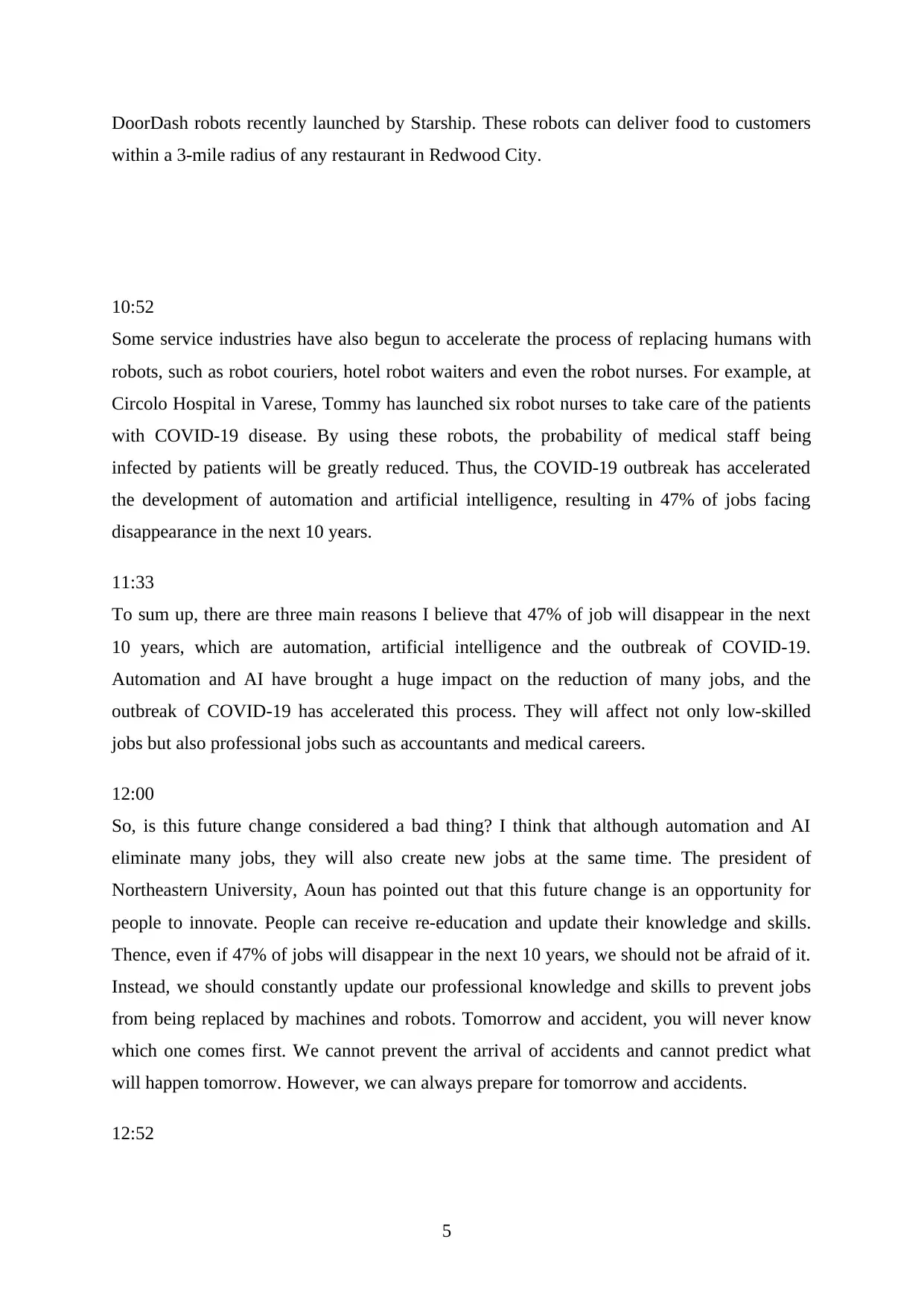
DoorDash robots recently launched by Starship. These robots can deliver food to customers
within a 3-mile radius of any restaurant in Redwood City.
10:52
Some service industries have also begun to accelerate the process of replacing humans with
robots, such as robot couriers, hotel robot waiters and even the robot nurses. For example, at
Circolo Hospital in Varese, Tommy has launched six robot nurses to take care of the patients
with COVID-19 disease. By using these robots, the probability of medical staff being
infected by patients will be greatly reduced. Thus, the COVID-19 outbreak has accelerated
the development of automation and artificial intelligence, resulting in 47% of jobs facing
disappearance in the next 10 years.
11:33
To sum up, there are three main reasons I believe that 47% of job will disappear in the next
10 years, which are automation, artificial intelligence and the outbreak of COVID-19.
Automation and AI have brought a huge impact on the reduction of many jobs, and the
outbreak of COVID-19 has accelerated this process. They will affect not only low-skilled
jobs but also professional jobs such as accountants and medical careers.
12:00
So, is this future change considered a bad thing? I think that although automation and AI
eliminate many jobs, they will also create new jobs at the same time. The president of
Northeastern University, Aoun has pointed out that this future change is an opportunity for
people to innovate. People can receive re-education and update their knowledge and skills.
Thence, even if 47% of jobs will disappear in the next 10 years, we should not be afraid of it.
Instead, we should constantly update our professional knowledge and skills to prevent jobs
from being replaced by machines and robots. Tomorrow and accident, you will never know
which one comes first. We cannot prevent the arrival of accidents and cannot predict what
will happen tomorrow. However, we can always prepare for tomorrow and accidents.
12:52
5
within a 3-mile radius of any restaurant in Redwood City.
10:52
Some service industries have also begun to accelerate the process of replacing humans with
robots, such as robot couriers, hotel robot waiters and even the robot nurses. For example, at
Circolo Hospital in Varese, Tommy has launched six robot nurses to take care of the patients
with COVID-19 disease. By using these robots, the probability of medical staff being
infected by patients will be greatly reduced. Thus, the COVID-19 outbreak has accelerated
the development of automation and artificial intelligence, resulting in 47% of jobs facing
disappearance in the next 10 years.
11:33
To sum up, there are three main reasons I believe that 47% of job will disappear in the next
10 years, which are automation, artificial intelligence and the outbreak of COVID-19.
Automation and AI have brought a huge impact on the reduction of many jobs, and the
outbreak of COVID-19 has accelerated this process. They will affect not only low-skilled
jobs but also professional jobs such as accountants and medical careers.
12:00
So, is this future change considered a bad thing? I think that although automation and AI
eliminate many jobs, they will also create new jobs at the same time. The president of
Northeastern University, Aoun has pointed out that this future change is an opportunity for
people to innovate. People can receive re-education and update their knowledge and skills.
Thence, even if 47% of jobs will disappear in the next 10 years, we should not be afraid of it.
Instead, we should constantly update our professional knowledge and skills to prevent jobs
from being replaced by machines and robots. Tomorrow and accident, you will never know
which one comes first. We cannot prevent the arrival of accidents and cannot predict what
will happen tomorrow. However, we can always prepare for tomorrow and accidents.
12:52
5

So, this is all of my speech. I do hope that this speech will help and provide you with new
knowledge. Thank you.
6
knowledge. Thank you.
6
⊘ This is a preview!⊘
Do you want full access?
Subscribe today to unlock all pages.

Trusted by 1+ million students worldwide
1 out of 6
Your All-in-One AI-Powered Toolkit for Academic Success.
+13062052269
info@desklib.com
Available 24*7 on WhatsApp / Email
![[object Object]](/_next/static/media/star-bottom.7253800d.svg)
Unlock your academic potential
Copyright © 2020–2025 A2Z Services. All Rights Reserved. Developed and managed by ZUCOL.

